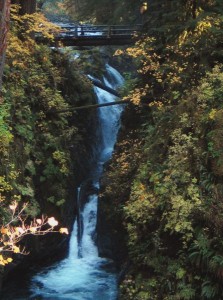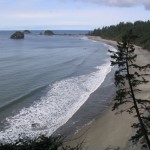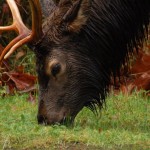WHAT
At about 3500 miles in combined length, the 15 Rivers and their associated waterways within Olympic National Park are comparable, in distance traveled, to a trip from the Park to the Panama Canal. This cumulative length is impressive; but it’s their liquid contribution that is critical to sustaining a pristine wilderness environment. Huge amounts of snow and rain ensure the rivers’ uninterrupted flow throughout the year.
Thirteen of the 15 rivers in ONP are designated “Wild and Scenic” under The U.S. Wild and Scenic Rivers Act. This designation provides a high degree of protection for the Park’s rivers, as well as for the abundant plant and animal communities dependent upon the rivers’ ceaseless and restorative flow. Twenty-nine native populations of fresh water fish, more than 70 unique stocks of Pacific salmonids and one fish species—the Olympic Mudminnow, which is found nowhere else—call these waterways home.
WHERE
US 101 encircles ONP like the rim of a wheel and the rivers of the Park flow outward from its center like spokes. Because the rivers were a means of access to the First Peoples and early settlers—and the roads follow in their footsteps—nearly all the major paved roads (colored red, on the Park Map) generally follow the rivers and provide easy access to them. Where the roads end the trails begin, and both pass by points of historical and scenic interest worthy of a stop.
WHY
On the Eastern and Northern flanks of the Park, eight rivers flow so directly from their alpine sources to sea level that they are included in a selective list of the world’s steepest rivers.  Even as the familiar sound of water flowing furiously downstream is heard, one can stand on the river bank and also hear a low muffled thud-thump as the force of the water propels submerged boulders downstream. This action is a direct consequence of the rate of flow and, as such, is most likely to be heard in the fall and spring run-offs. Spawning salmon, as well as the eagles awaiting to feast on them, are usually viewable in late October. Just look for eagles sitting in the trees, after their leaves drop to the river’s edge in the fall.
Even as the familiar sound of water flowing furiously downstream is heard, one can stand on the river bank and also hear a low muffled thud-thump as the force of the water propels submerged boulders downstream. This action is a direct consequence of the rate of flow and, as such, is most likely to be heard in the fall and spring run-offs. Spawning salmon, as well as the eagles awaiting to feast on them, are usually viewable in late October. Just look for eagles sitting in the trees, after their leaves drop to the river’s edge in the fall.
The restoration of the Elwha River, 15 minutes west of Port Angeles on US 101, is a story of the effect of human impact on the environment. The short story is that early in the 1900’s two dams were built on the river, effectively eliminating its salmon runs. Removal of the dams began in September 2011 and will result in the largest, most protected stream habitat in the world. The image below shows the one of the dams, and a projection of what the river will look like after its removal.
For more information about the Elwha River Restoration Project, visit these web sites:




